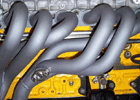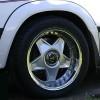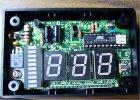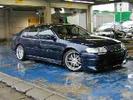| Author | Topic |
|---|

Location:
Lost in the K hole
Registered:
May 2002
|
 How does the 7m-gte boost retard ?? How does the 7m-gte boost retard ??
|
 Wed, 27 November 2002 03:51
Wed, 27 November 2002 03:51

|
 |
when the 7mgte comes on boost, how does the ecu know ??
i mean, timing has to be retarded, and fuel has to be upregulated. please, someone tell me it just doesnt figure out the timing through the knock sensors, and the fuel through AFM....
cheers
ed
|
|
|

Location:
North Sydney
Registered:
May 2002
|
|
Re: How does the 7m-gte boost retard ??
|
 Wed, 27 November 2002 04:22
Wed, 27 November 2002 04:22
 
|
 |
The factory 7mgte ecu doesn't care if the engine is on boost or vaccuum. It means nothing to the ecu. It only meters how much air and its density is flowing through the Air flow meter and puts the corresponding amount of fuel with it depending on load which is set through the TPS and RPM from the crank angle sensor.
Ignition timing is set through a pre-determined look up table on the eeprom for anything but "cruise" conditions(eg freeway light cruising conditions). It doesn't use the knock sensors for this contrary to many ppl's beliefs. The knock sensor is only used in cruise conditions. No engines listen to the knock sensor under load as a sensor failure would kill the engine in a matter of minutes. Also there is too much interference noise emitted from valves and harmonics in higher RPM for it to be able to detect real knocking.
The ignition is retarded on according to the voltage output of the AFM, TPS output, water temp and of course RPM.

|
|
|

Location:
Brisbane
Registered:
May 2002
|
|
|
Location:
perth
Registered:
November 2002
|
|
Re: How does the 7m-gte boost retard ??
|
 Wed, 27 November 2002 04:44
Wed, 27 November 2002 04:44
 
|
 |
On a related note there's no such thing as "fuel cut" cos it's actually an ignition cut .. cutting fuel at high RPM would cause an extremely lean situation and things would be melted
probably best refered to as an overboost cutout
HTH
scottee
|
|
|

Location:
Brisbane
Registered:
May 2002
|
|
Re: How does the 7m-gte boost retard ??
|
 Wed, 27 November 2002 05:27
Wed, 27 November 2002 05:27
 
|
 |
Yes it creates an extremely lean condition, so lean in fact that nothing burns which means there's no chance of melting stuff! I'm pretty sure it's a fuel cut; if it was ignition cut you would get massive flames out the exhaust every time it does it, and I haven't seen any flames (and I have witnessed "boost cut" many many times thanks to my insane friends).
|
|
|
Location:
perth
Registered:
November 2002
|
|
Re: How does the 7m-gte boost retard ??
|
 Wed, 27 November 2002 05:40
Wed, 27 November 2002 05:40
 
|
 |
hmmmmm food for thought .. when i've observed it there is usually a puff of black smoke imediately after indicating a rich condition, which is the main reason i thought it was ignition. Was told the same thing by a few people in the states too
scottee
|
|
|

Location:
Lost in the K hole
Registered:
May 2002
|
|
Re: How does the 7m-gte boost retard ??
|
 Wed, 27 November 2002 08:24
Wed, 27 November 2002 08:24
 
|
 |
ok, so the ecu is simply running off predetermined ignition maps, and fuel is based on the AFM only. cool. any idea if the ignition maps would be any different between the ge and gte. and i imagine the fuel/air tune would be the same/similar too.
just curious.
also, paul, the crank angle sensor you mention, does the gte run a dedicated hall effects type crank sensor, or does it just use the cam angle sensor for this purpose.
cheers
ed
|
|
|

Location:
North Sydney
Registered:
May 2002
|
|
Re: How does the 7m-gte boost retard ??
|
 Wed, 27 November 2002 13:15
Wed, 27 November 2002 13:15
 
|
 |
Yep massive difference between 7mge and 7mgte fuel and ignition maps.
Fuel is also determined off RPM and TPS. You put your foot down and if the TPS changes over a certain amount in less than the preset time then a "Pump" situation is registered which gives a decent percentage of extra fuel to aid response.
A/F tune is also different, the target a/f ratios on the gte are richer to starve off detonation by putting in more fuel to stop hotter pockets igniting before they are meant to. The richer a/f ratios and density in the exhaust gases also help turbo spool because they have a greater force on the exhaust turbine. Lots of other reasons why they run different ratios, that's just two.
With the ge they run leaner a/f ratios because cylinder pressures are lower and less likely to detonate also.
As for the CAS,I think it may be optical(fairly sure), with teeth cut out of the disc. The ecu recognises these cut outs and the disc has one extra notch to denote TDC. I might be getting this mixed up with another CAS.Ill have to think about it for a bit.
|
|
|
Registered:
May 2002
|
|
Re: How does the 7m-gte boost retard ??
|
 Wed, 27 November 2002 13:36
Wed, 27 November 2002 13:36
 
|
 |
| SUPRAGTE wrote on Wed, 27 November 2002 14:52 |
The knock sensor is only used in cruise conditions. No engines listen to the knock sensor under load as a sensor failure would kill the engine in a matter of minutes. Also there is too much interference noise emitted from valves and harmonics in higher RPM for it to be able to detect real knocking.

|
don't wanna be a smartarse or nothin but what about the 3TGTE? doesn't the knock sensor only kick-in near full load, only working when boost goes above a certain amount which is measured through the knock pressure switch, or does it only work UNDER a certain boost? I'm still getting my head around these knock sensors, i've gotta try and wire up my knock computer sometime 
|
|
|

Location:
Lost in the K hole
Registered:
May 2002
|
|
Re: How does the 7m-gte boost retard ??
|
 Wed, 27 November 2002 13:41
Wed, 27 November 2002 13:41
 
|
 |
interesting.
i wonder if this whole mechanism of fuel calculation (pretty dodgy by my reckoning) would go some way to explaining the number of BHG's these engines get (in addition to head bolt tourque).
its interesting that the ge and gte would have different fuel maps. i mean if im reading it right, off boost, the gte would be running richer, despite the fact that it would effectively be a NA with a lower c/ratio than the GE etc in such a situation.
hmmmmm....
so any idea what the boys do when they run GE hi comp pistons in their GTE's ?? aftermarket ecu for fuel management, or they get away with a RRFPR or something....
hmmmm...
and Paul... by the CAS you mean the cam postion sensor (aka crank position sensor) hanging off the driver's side of the head ?
cheers
ed
|
|
|

I supported Toymods
Location:
I renounced punctuation
Registered:
May 2002
|
|
|
I supported Toymods
Location:
Brisbane, QLD
Registered:
May 2002
|
|
Re: How does the 7m-gte boost retard ??
|
 Wed, 27 November 2002 22:20
Wed, 27 November 2002 22:20
 
|
 |
Yeah, along the same lines of thought as GT, have a couple of questions.
1. Does the 7M-GE and 7M-GTE use the same AFM?
If they are the same, I am guessing the fuel and ignition tables for open loop operation are somewhat extended in the GTE (to facilitate the additional airflow) and as such, as GT was asking above, under no boost conditions, the relevant parts of the maps should be somewhat similar?
If that is not the case, if indeed the AFMs are different, then what you could possibly get is a scaling factor in action, where the 7M-GTE maps could be potentially the same size as the 7M-GE maps, but would be scaled to facilitate a higher range (at a lower resolution obviously). Even in this case, with the 7M-GTE ECU and a 7M-GTE AFM, wouldn't the relevant portions of the fuel/ignition maps be somewhat similar between the two?
Paul, under what conditions does the 7M-GTE ECU go into closed-loop (cruise) control? I was told that there is a pre-determined coolant temp it's looking for (possibly to make sure that the O2 sensor has sufficiently heated up?) and I was told that above 75% open throttle (WOT) the ECU goes off closed-loop. Does this mean that if the engine has been running for a few minutes and the throttle is below 75% open, the ECU runs in closed-loop?
Is the "Pump condition" enrichment also table based or is it just a "increase the fuel flow by x%" type thing? Under "pump condition" does the ECU use maps for ignition as well?
Cheers
|
|
|

Location:
Brisbane
Registered:
May 2002
|
|
Re: How does the 7m-gte boost retard ??
|
 Wed, 27 November 2002 22:42
Wed, 27 November 2002 22:42
 
|
 |
From what I have read, the GE and GTE engine management systems are quite different. I'm pretty sure the AFM is different as well. And no, there aren't any MAP sensors anywhere.
|
|
|

I supported Toymods
Location:
I renounced punctuation
Registered:
May 2002
|
|
Re: How does the 7m-gte boost retard ??
|
 Wed, 27 November 2002 23:05
Wed, 27 November 2002 23:05
 
|
 |
|
GTE has the Karman vortex AFM, and I always presumed the GE has a flapper style AFM.
|
|
|

Location:
North Sydney
Registered:
May 2002
|
|
Re: How does the 7m-gte boost retard ??
|
 Thu, 28 November 2002 12:19
Thu, 28 November 2002 12:19
 
|
 |
Inferno-
i'm definitely certain it doesn't use the knock sensors when up into the load range on the 3tgte. It doesn't only "kick in" when up near full load either as you say from the knock pressure switch. I've haven't heard of a knock pressure sensor either. You can have pressure sensor's and knock sensors but not combined. They are totally separate, one measures ultra-sonic waves with a piezo ceramic material and a pressure switch just makes or breaks a contact at a ceretain positive pressure.
As i say, there's not an engine out there yet that does use it when under load that i know of yet. They all use pre-determined lookup tables from eeprom's when on load that's why aftermarket computers are so good when doing mods to improve airflow, power etc from the engine.
Cause the factory ecu doesn't realise when you put a massive intercooler on with 2.5 inch piping the lookup table stays the same as if it has a restrictive cooler for example. There are gains from bolting these straight on but even bigger gains when can throw in a heap of extra ignition timing to get the most out of your new bits.
ED-
The way these engineers at toyota and many other companies measure airflow and determine injector pulse widths and ignition timing just isn't dodgy. It came from F1 which puts millions into research in the quest for excellance and then the major car manufacturers do it all over again.
AFM's are the most accurate within economical reasons.
How else would you measure how much air is going into an engine??? It's got nothing to do with the BHG issues.
When the guys run the GE high comp pistons on their GTE's??????
That sorta defeats the purpose. The lower the compression the better, for turbo engines anyway. That's why you'll see Rigolli's 7MGTE running lower comp JE pistons(8:1 lower than factory 8.4:1) not higher compression. The lower the compression the more boost you can throw in the more power you will get to a point. Now if you run higher comp pistons you can't run hardly any boost because of detonation occuring because of the higher combustion pressures. Running GE(think they are something like 9.5:1) pistons in a GTE would allow you to run like 5psi of boost and this defeats the purpose of a high performance turbo car. It would be nice and responsive off boost but the turbo on boost power is the whole reason you have a turbo car in the first place.
As for if you did run GE pistons in a GTE you would should definitely run an aftermarket CPU for fuel and ignition timing cause you'll have to minus a swag of ignition timing off to stop the detonantion. The timing is where you get the most of the power. More advance = more power, its that easy.
I advance my ignition maps while on a dyno by 5deg accross the entire map by whats called a "blanket map change" and netted 30rwhp extra at the top end and a very healthy increase all the way through.
The CAS, crank angle sensor or cam angle sensor. They both simply telly you the position of the cylinder no 1 and its relation to TDC. From this the CPU can work out the posi of every other cylinder and at how much advance to fire them.
Gianttomato- they wouldn't have the same amount of air off boost as each other as they have different compression ratios therefore different combustion chamber sizes therefore different amounts of fuel to go with different amounts of air in those combustion chambers.
Humble- i dont have the exact figures on at which the ECU goes into cruise conditions. I'm pretty sure it is 0-25% TPS though, could be higher but you wouldn't really be cruising with up to 75% TPS. You would be more likely giveing it a kick in the pants.
Yep it is coolant sensor activated, must be between i'd say 82-90deg C before it will allow this. Cause your engine is automatically enriched when the engine is cold(to make it run smoother) if it tried to go closed loop on the 02 sensor it would see A/F ratios too rich and lean it off and your back to where you started from.
The pump is condition based. (Ie if at 6000RPM dont allow pump)Yes it does adjust the ignition timing, it advances it. My microtech setup adds 5deg when it sees my foot go down really quickly to give better response a feel.
What a bloody huge post, i'm not even going to bother proof reading that, battery on the laptop is about to die!!! Quick submit!!!
RPM activated
[Updated on: Thu, 28 November 2002 12:22]
|
|
|

Location:
Lost in the K hole
Registered:
May 2002
|
|
Re: How does the 7m-gte boost retard ??
|
 Thu, 28 November 2002 13:25
Thu, 28 November 2002 13:25
 
|
 |
| SUPRAGTE wrote on Thu, 28 November 2002 23:19 |
AFM's are the most accurate within economical reasons.
How else would you measure how much air is going into an engine??? It's got nothing to do with the BHG issues.
>>>>
When the guys run the GE high comp pistons on their GTE's??????
That sorta defeats the purpose. The lower the compression the better, for turbo engines anyway.
>>>>>
Gianttomato- they wouldn't have the same amount of air off boost as each other as they have different compression ratios therefore different combustion chamber sizes therefore different amounts of fuel to go with different amounts of air in those combustion chambers
|
paul, whilst the afm itself is verygood at determining airflow, im just saying that by the ecu NOT monitoring intake pressure, it is rather simplistic in its fuel and timing calulations. and whilst its probably a-ok, it is forseable that such a sinmplistic stock fuel managment system could be partially responsible for h/g issues.
as far as the concept of a hi static comp turbo engine goes... yeah ok, you might not be ABLE to run heaps of boost, but equally, you dont NEED to run heaps of boost. the high static compression results in huge dynamic compression under boost (even low levels) and if you get the fuel and timing right (and you dont need to retard it to hell always - consider combustion chamber design and intake/fuel swirl characteristics) they make an awesome performnace engine. consider porsche, 9.4:1 static compression turbo 
and yes, people have run ge pistons in a turbo/supercharged applications...
and just on your last point... CR has nothing to do with airflow. the swept volume is still the same between the two engines...ie they suck in the exact same amount of air, the CR just determines how compressed that volume air becomes at TDC
cheers
ed
|
|
|

Location:
North Sydney
Registered:
May 2002
|
|
Re: How does the 7m-gte boost retard ??
|
 Fri, 29 November 2002 06:38
Fri, 29 November 2002 06:38
 
|
 |
Ed- the airflow meter is the best way of measuring air going into the engine to add the precise amount of fuel and get the correct A/F ratios. It measures the exact amount of air precisley going into the engine regardless of pressure.
Measuring the pressure in the intake manifold doesn't give you how much air is going into the engine. It merely gives you pressure. What happens when you do some porting? The pressure in the intake manifold stays the same but more air is going through the engine. Your theory doesn't work on using the pressure isn't the best.
The AFM will take all these mods into account and again measure the precise amount of air going into the engine with the new mods.
Again its not a simplistic setup and absolutely nothing to do with BHG's. It's alot better than MAP sensor setups but Toyota has gone to these for costs savings.
CR has got something to do with AF ratios. How could it not? There is less volume in the combustion chamber for higher compression engines. Agreed???? Thats why they are higher compression. If you put the same amount of fuel with the less volume you will get richer AF ratios. Its obvious.
The engines have the same sweep but lower comp engines have more taken out of the pistons to give the lower comp which inturn gives greater volume in the combustion chamber.
I wouldn't be running GE pistons in my GTE but that's by choice because I want to run decent boost(14psi) with alot of ignition timing and get some top end power numbers.
If it were such a good idea wouldn't everyone be running higher comp pistons on their turbo engines instead of lower?
|
|
|

Location:
Lost in the K hole
Registered:
May 2002
|
|
Re: How does the 7m-gte boost retard ??
|
 Fri, 29 November 2002 12:32
Fri, 29 November 2002 12:32
 
|
 |
| SUPRAGTE wrote on Fri, 29 November 2002 17:38 |
Measuring the pressure in the intake manifold doesn't give you how much air is going into the engine. It merely gives you pressure. What happens when you do some porting? The pressure in the intake manifold stays the same but more air is going through the engine. Your theory doesn't work on using the pressure isn't the best.
|
no, youre right about the calculation of airflow, but im talking about timing...when you increase intake pressure, you're effectice compression ratio increases, and this needs to be compensated for by timing rertard. trying to calculate this effective CR simply through predicitve RPM, TPS and AFM signals is not an optimum solution...
| SUPRAGTE wrote on Fri, 29 November 2002 17:38 |
CR has got something to do with AF ratios. How could it not? There is less volume in the combustion chamber for higher compression engines. Agreed???? Thats why they are higher compression. If you put the same amount of fuel with the less volume you will get richer AF ratios. Its obvious.
|
not so. just think about it again 
the volume in the combustion chamber of a high CR engine still contains the same amount of air and fuel as an identical lower CR engine... but at higher pressure. thats it. (ok maybe ~5ml less total volume, but this 5mls is NOT manifested in a change in the volume of air ingested. it's contained within the dead space of the cyl, and does not come into AF calculation) perhaps in a turbo application, the extra 5mls of volume will be pressurised to yeild say an extra 7mls total volume over a hi comp... BUT relating back to your original point that a high comp doesnt suck in as much air and fuel as its lower comp counterpart, thats still incorrect.
a highr CR engine may also require more fuel simply to keep the compustion temperatures down, but that is a deliberate tuning allowance made in the ECU, and nothing inherent to the engine's physical design.
| SUPRAGTE wrote on Fri, 29 November 2002 17:38 |
If it were such a good idea wouldn't everyone be running higher comp pistons on their turbo engines instead of lower?
|
because its hard to pull off. magin for error in manufacture, tuning, fuelling and maintenance is extreemly low, and the engine is very highly strung. not the kind of car manufacturers want mom and pop driving around.
as for hi performance modifications... again, its just easier to drop CR in order to run big boost. much harder to run hi static CR and then run mid/low boost. but, when it is done, look out, she does go...
cheers
ed
|
|
|

I supported Toymods
Location:
Perth
Registered:
May 2002
|
|
Re: How does the 7m-gte boost retard ??
|
 Sat, 30 November 2002 07:28
Sat, 30 November 2002 07:28
 
|
 |
|
What Ed is basically commenting on, is the fact that every pound of boost pumped into an engine produces more power in a higher compression engine than in a lower one. You can run heaps of boost to make up for it, but then you will miss out on the extra low-end and mid-range that is needed on the street and out of corners on a track.
|
|
|

Location:
North Sydney
Registered:
May 2002
|
|
Re: How does the 7m-gte boost retard ??
|
 Sun, 01 December 2002 06:13
Sun, 01 December 2002 06:13
 
|
 |
Ed the volume of air going through the airflow meter on a 7MGTE engine will tell you exactly how much pressure is in the manifold.
The 7MGTE also measures the temp of the incoming air and this gives you the exact density so you have precisely the amount of air going into the engine.
Density X Flow = Volume
From this pressure is calculated. Thats how the ignition is retarded.
| Quote: |
no, youre right about the calculation of airflow, but im talking about timing...when you increase intake pressure, you're effectice compression ratio increases, and this needs to be compensated for by timing rertard. trying to calculate this effective CR simply through predicitve RPM, TPS and AFM signals is not an optimum solution...
|
The ECU doesn't care what the effective CR is. It's only concerned with A/F ratios out the exhaust and if they are within setpoints.
Different compression ratios will affect the AF ratios and thats what i was saying in the first place. I stand by that. It will affect it.
If you have the same injector pulse width on a 10:1 engine as a 8:1 CR engine you will get vastly different AF ratios.
|
|
|

Location:
Brisbane - Chapel Hill
Registered:
June 2002
|
|
|

Location:
North Sydney
Registered:
May 2002
|
|
Re: How does the 7m-gte boost retard ??
|
 Tue, 03 December 2002 02:50
Tue, 03 December 2002 02:50
 
|
 |
Cheers Esteban, its easier to see in a diagram hey.
Fark that must have taken some time.
A picture is a thousand words, too true.
|
|
|

Registered:
November 2002
|
|
Re: How does the 7m-gte boost retard ??
|
 Thu, 02 January 2003 17:05
Thu, 02 January 2003 17:05

|
 |
http://www.afn.org/~wjh/tsc/supra/afmtune/afmtune. htm
According to this page the air flow meter can be modified to change the resistance reading sent to the ECU thus allowing u to get more fuel to create more power 
|
|
|